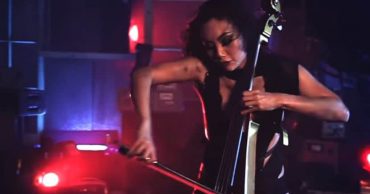“More is more.” It’s the seminal concept which is a constant in the music of Rush. It’s also the lifelong principal which drives Geddy Lee. He’s always believed that he should learn about things that turn him on. He’s obsessive about those things. When he’s interested, he wants to learn every detail and facet about his obsession. He’s known for his obsessions with wine, baseball, and music. It’s his particular genius.
Geddy’s persistent search for “more” was always accompanied by “better”. Geddy’s facility with keyboards matched his bassist talent. The band maintained their three-man structure, while adding more music textures and interesting new sounds to their music. They accomplished this goal gradually. Geddy described the process as starting with double-necked guitars, followed by bass pedals, mini-Moogs, synthesizers of all kinds, and “monstrous constructions of devices”. They combined technologies and added systems which would include more variety in their music.
Geddy served as Rush’s magnificent bass-player, singer, and keyboardist … all at one time. His innate musical genius allowed him to add layers of technology to increase Rush’s musical capacity. His technical prowess and musicality allowed the band to become ever more creative. His bandmates have said that it has always been a mark of pride for Geddy that he never surrendered his roles by adding other players to the trio.
By the 1980s, Rush had entered its synthesizer dominant era. Geddy’s synthesizers had been featured for a decade, with Geddy’s signature counterpoint backgrounds supporting the guitar lines and merging with the percussion. But Geddy’s synthesizers and sequencers moved to the forefront, creating rich, multi-layered sonic textures. These complemented Neil Peart’s new incorporation of electronic percussion and drums, and Alex Lifeson’s guitar riffs enhanced with new-wave rhythms and reggae chords.
In 1983, Rush performed a warm-up tour preceding the release of the Grace Under Pressure album in 1984. During the tour, Geddy was surrounded by the largest array of sequencers, keyboards and synthesizers he had ever used. The music is considered by many critics to be some of the most innovative Rush created.
Red Sector A is one significant track from the album, because it was partially inspired by Geddy’s mother’s liberation from the Bergen-Belsen Nazi concentration camp. Geddy’s father was liberated from Dachau several weeks later. Geddy said that the entire Grace Under Pressure album is about courage and the will to survive. The album is set in an apocalyptic future, but ultimately deals with what Neil Peart called “the essence of grace”. Red Sector A is a NASA launch area, and gave the song its title.
Rush’s massive and exciting technology provide many new musical textures in this live performance:
On a Planet Rock question and answer session, Rush fan Mark Slater asked Geddy about the colored discs he saw placed strategically on Geddy’s keyboards. Geddy answered that his keyboard functions as a keyboard on some songs and as a device for triggering sequences on other songs. The methods for triggering the keyboard are complicated. Because the lights often go out during the concert, Geddy uses glow-in-the-dark colored discs to help him quickly find the correct keyboard position he needs when he changes from guitar to keyboard. The colors are coded to specific songs, and the system helps him to keep things straight.
This is classic Geddy, managing his keyboard station, singing, and playing bass. Note the spectacular drum array and hear the full, orchestral sound the three band members produce:
Geddy first started thinking about playing guitar after hearing Roy Orbison singing “Pretty Woman”. He liked the tone of the guitar and the “nature of the riffs”. Buying a guitar for himself, and learning how to play it, changed his life. He said that he was thrilled to be a bass player, because he could “play lead lines down below” the melody, where he could hide. When Rush was formed, nobody in the group wanted to sing, so Geddy decided he would. Geddy’s fellow band members have described Geddy as an expressive interpreter of songs. For them, Geddy is a singer who transfers his expressive singing to his bass playing. They have said that Geddy is able to perform bass lines in ways that no other bass players do.
One of Geddy’s mind-blowing bass solos:
In later years, Rush had access to modern technology which required less equipment on stage during tours. They still performed their classics, but often filled the empty spaces with interesting stag props. In this performance, it’s easy to see Geddy using his trademark bass pedals, and his synthesizer array is decorated with steampunk style décor. It’s phenomenal, high energy Rush and some great glimpses of Geddy playing their classic “Subdivisions” at his synthesizer station:
Geddy is disciplined. He told a fan that he remembers his music because he practices alone for two weeks before a tour begins. Then, he practices for five weeks with the band, and follows that with another four weeks with the entire production team.
Here’s what excellent preparation produces:
Getty grew up in what he’s famously called “the visually boring suburbs”. He thought of himself as average in those days… a daydreamer who “could do better if he’d just apply himself”. Geddy applied himself in a big way. The multi-layered, visual and musical experiences of Rush far surpass those old suburbs. Rush is rock ‘n’ roll majesty and Geddy remains incredible Geddy:
 Follow Us
Follow Us


